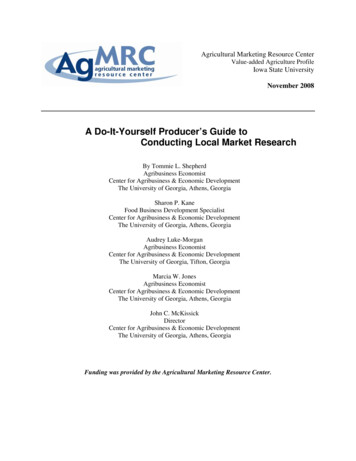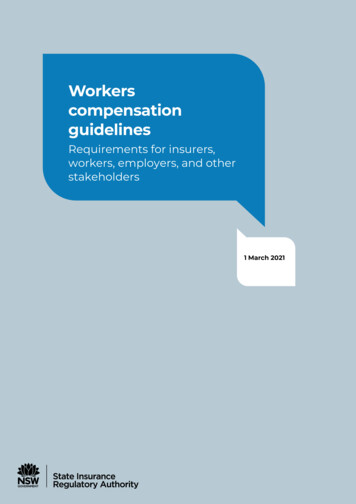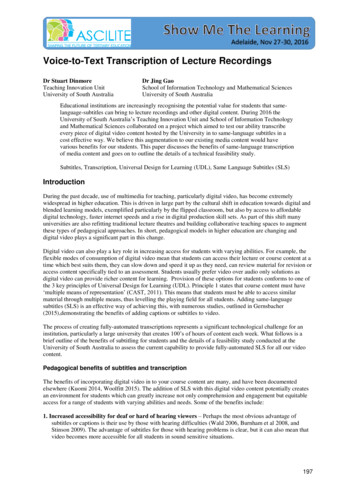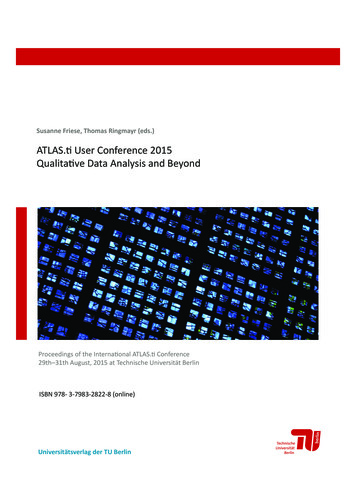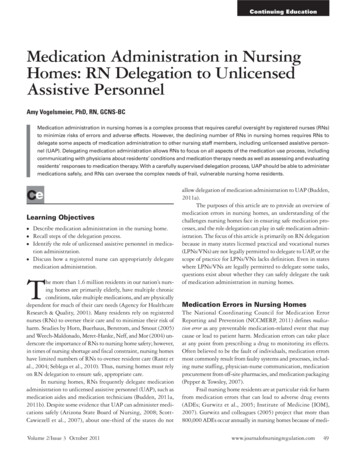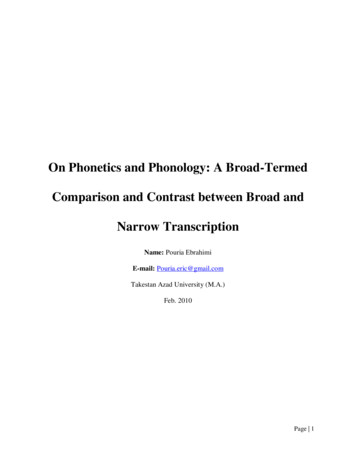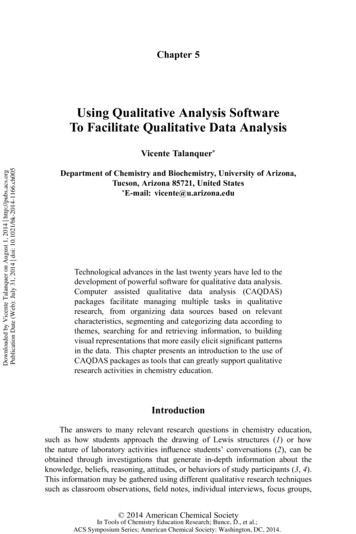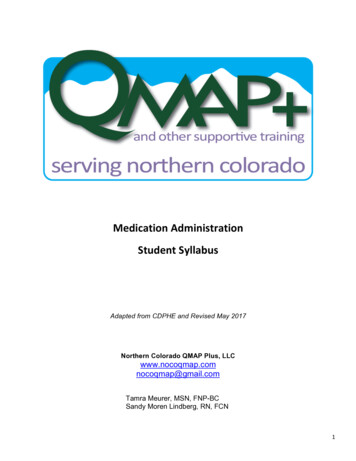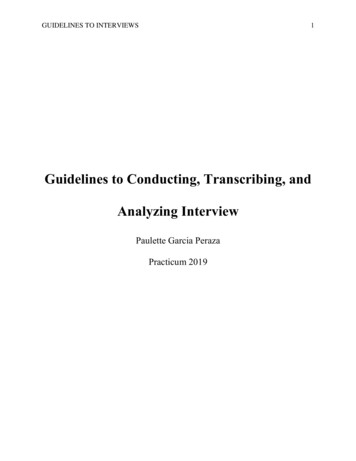
Transcription
1GUIDELINES TO INTERVIEWSGuidelines to Conducting, Transcribing, andAnalyzing InterviewPaulette Garcia PerazaPracticum 2019
2GUIDELINES TO INTERVIEWSTable of ContentsInterview Protocol Guidelines . 3A. How to Develop an Interview protocolB. Tips for Conducting InterviewsTranscription Guidelines . 5A. Checklist for TranscribingB. Checklist for Checking TranscriptC. Formatting TranscriptsD. Transcription TipsE. Transcription SymbolsF. Transcription LogThematic Analysis Guidelines 12
GUIDELINES TO INTERVIEWS3How to Develop an Interview ProtocolTo develop an interview protocol, there are a few suggestions that might guide the type ofquestions, number of questions and how the research approaches the interview and interviewprotocol. These include:o Start with the broader research question that guides the study.o Develop a description of the broader research question to help with recruitment.o Form a question that is related to the experience of the interviewee and which frames theinterview and creates rapport.The flow of the interview protocol can vary. I suggest starting with warm-up questions that areeasier to answer and moving onto the more difficult questions and ending with easier questions.Warm-up questions might include asking about the interviewee’s background (e.g., Where didyou grow up?) The questions that are related to the experience of the interviewee and which youare most interested should be more towards the middle once the interviewee is more comfortable.The final questions should be similar to the warm-up questions in wrapping up the interview andproviding easier to answer questions.In developing the questions, here are a few tips:o Focus on having questions that are open-ended and allow for the interviewee to provide athorough response.o Try not to include why questions which may place judgement or assume cause-effectrelationships. Instead word questions like “Tell me more about ”o Try to avoid double barreled questions and only ask a single question.o Try not to include dichotomous yes/no questions but instead allow for open-endedquestions. I suggest this because the interview is limited in time so each question shouldbe important.o Prepare follow-up questions and probes to get more clarity on something you don’tunderstand or on some missing information, or if the interviewee brought something upthat other interviewee’s have not discussed. These questions can also be developed whiledoing the pilot testing because it may provide a general idea of what to further ask forclarifications.o Try not to use jargon that interviewee’s may not be familiar with and which might makethem feel distant from you.In the process of developing the interview protocol, there might be a few steps needed to refinethe questions. First, develop the main questions of the protocol and make sure that they provideinsight to the broader research question. Then develop transitions, introduction and conclusionparagraphs, and follow-ups and probes. After these steps, have others review the questions forfeedback on the clarity of the questions, making sure they avoid some of the issues discussedearlier, and that they relate to the research question. Finally, pilot test the interview protocol withothers that can provide feedback on the questions, and on the researcher’s demeanor during theinterview (Castillo-Montoya, 2016).
4GUIDELINES TO INTERVIEWSTips to Conducting an InterviewPrior to an interview:o Practice the interview to gain familiarity with the protocolo Check the recording device to make sure it works properlyo Introduce yourself and provide relevant information about yourself related to the project.This can include why you might be doing the project.During the interview:Be an active listenerTreat the interviewee with respect and sensitivityAllow for silences (wait times)Provide emphatic responses that include summarizing what the interviewee said andpossibly describing what they might have felt.o If interviewee gets upset or cries, give them a moment to collect themselves or time tostep out. Also provide the option to discontinue the interview or reschedule.ooooAfter the interview:o Thank and debrief the participant to talk about anything emotional that they may havediscussed during the interview and which you didn’t get a chance to discuss. This is alsothe opportunity to share your own experience if you have any experiences that relate tothe interviewee.o Check to make sure the audio recorded properly. If not, write down as much as youremember from the interview.o Log any reactions or thoughts because being reflective of the process might provide someinsight during the analyzation and writing process. It also helps to reflect on how youreacted for each interview to understand how to be a better interviewer for the nextinterviewee.ReferencesCastillo-Montoya (2016). Preparing for interview research: The interview protocol refinementframework. The Qualitative Report, 21, 811-831. Retrieved elson, R. (2013). Interviewing for qualitative inquiry: A relational approach. New York,NY: The Guilford Press.Rubin, H. J., & Rubin, I. S. (2005). Qualitative interviewing: The art of hearing data (2nd 52226651
GUIDELINES TO INTERVIEWS5Checklist for TranscribingBefore starting the transcription process make sure: Transcription process has not been started by someone elseo If not, then write initials and start date in the transcription log PGP, 7/1/19During the transcription process: Play the video or tape a few minutes before you start actually transcribing. This will helpyou determine the pacing of the interview, so you can adjust the playback for thetranscription and your typing speed. (typically about .5x-.6x) Include comment for any abbreviations, words you are unsure of, or portions of thetranscription that were inaudible:o Note: Unsure of this abbreviationo Audio: 14:06After the transcription process: If the transcription is not complete, then add a note of where you left off:o Left off: PGPo Audio: 10:03 If transcription is complete, then sign off in the transcription log & add a short paragraphat the bottom of the transcript with reactions/thoughts Add or update a color tag to the file (see File Keys) Recheck the transcription once the other person has finished checking itOther notes: If you see a theme or story emerge, then include the quote, theme, line number and pagenumber in a separate word or excel documento Make sure to write a description of what the theme/story means to you so thatothers can find similar themes in other transcripts and so that you can refer to it touse in other transcriptions as well.o Look for themes after you’re finished with transcribing (for the day). This allowsfor more time to think about the theme and what they mean before continuing to adifferent part of the transcription.
GUIDELINES TO INTERVIEWSChecklist for Checking TranscriptBefore starting the checking process make sure: You did not transcribe the interview Checking process has not been started by someone elseo If not, then write initials and start date in the transcription log PGP, 7/1/19 Track changes is turned on in Microsoft WordDuring the checking process make sure: Edit the format according to the formatting transcripts guideline Change identifying information on the transcript (see more info on transcribingguidelines). If you aren’t sure of their relationship to the participant, then include acomment:o Unable to change ID infoo Audio: 24:30After the checking process: If checking the transcript is not complete, then add a note of where you left off:o Check transcript left off: PGPo Audio: 10:03 If checking the transcript is complete, then sign off in the transcription log & add a shortparagraph at the bottom of the transcript with reactions/thoughts Add or update a color tag to the file (see File Keys)6
7GUIDELINES TO INTERVIEWSFormatting Transcripts Font should be Times New Roman, 12 point, single-spaced, and the document shouldhave 1” margins Header should have:o Participant’s ID number (PID #XX) in the left cornero Page number in the right corner Include line numbers that restart after each page Use P (participant) and I (interviewer), with a single space between each one.I: Tell me more about your experience in collegeP: Well, so far I’m having a great time in college.I: Can you tell me a little bit more about that? Indentation should be 0 for each main question, 0.25” for responses to the main question,0.50” for each sub-question, and 0.75” for each response to the sub-question. Seeexample below1. What was your favorite subject in high school?P: Well, I liked both math and history.I: Can you tell me more about the subjects you liked?P: Yes, math wasn’t easy for me, but I had a teacher that made it simple and shealways gave us examples
8GUIDELINES TO INTERVIEWSTranscription GuidelinesWrite exactly what they say, even if it is grammatically incorrect or doesn’t make much sense.Example: using “cuz” instead of becauseInclude interjections like “hmm”, “uh”, “woah”, “yeah”, “okay”, “um”, “ohh”, “mmm”Mmmm [no]Mhmm [yes]Include nonverbal communication (e.g., laugh, sigh, quietly) in brackets. These should be inpresent tense.Example: (laughs) graduate school was an interesting experience.Don’t include repetitions of words.Example: She-She didn’t know what I was talking about.Change identifying informationMake sure to change any information that they mentioned like their own name or namesof other people. To do this, blank out the name (7 underscores) and add the relationshipinformation on the side in brackets.Example: I really did want (sister) to complete her bachelor’s degree.Numbers less than tenFor any numbers less than 10, write out the numbers in words. However, for numbersgreater than 10, write them out in numerical form.Out of order questionsKeep the original question and include see above (or see below) and page #. Also ifsomething was answered in a previous question and that’s why it was not asked, then put Notasked, see above, or Not asked, see question or page #.File KeysUse to organize the files within each of the foldersFile KeysNo dot Needs to be transcribed and checked Transcribing in progress Transcribing completed Checking in progress Checking completed Checking by transcriber in progress Transcription and checking complete
9GUIDELINES TO INTERVIEWSTranscription SymbolsComma (, )Use to indicate a short pause of about 1-3 sec. Example: So, when I was, umm, writingthis guideline I was getting distracted, and then um I finally wrote it up.Ellipses ( )Use to indicate when the participant is trailing off or has a longer pause (3 seconds) atthe beginning of a sentence. Because this is generally used to indicate that information is missingin APA, then make sure you only include it at the beginning or end of a sentence. Example: Sowhen I was writing this guideline I was getting distracted (pauses)If the pause is long and in the middle of a sentence (3 seconds), then use this symbolinstead of the ellipses. Example: I had never thought about grad school (pauses) well actually Idid think about it a little when I was in high school.Em dash ( )Use to indicate change in the speech, like repeating the same word, or abruptly changethe language. There should be no space either before or after an em dash. Example: I want needed to take this class my senior year but the school didn’t offer it.Underline ( )Used to emphasize certain words. Example: The class was really difficult because I didn’tfeel like I could as others for help.Brackets []Used to indicate words added to the transcription that the interviewee did not mention, toexplain certain abbreviations, or translate a word in another language into English. If theparticipant mentions this abbreviation multiple times, only use it the first time the participantmentions the abbreviation. Example: I participated in the CITL [Center for Innovations inTeaching and Learning] program my first-year of graduate school.Slashes (//)Used to show that the participant and interviewer overlap in the time when they talked toeach other. Example: That sounds difficult that // It was difficult especially during graduateschool.Quotes (“ ”)Used to demonstrate what someone said. Do not use when the person was only thinkingof something, but didn’t say anything. Also, remember to capitalize the first word of the quote,regardless of where it is in the sentence, and to add commas, periods, and questions marks insidethe quotation marks. Example: I told my sister, “You should really tell the professor that the TAdidn’t show up.” But she said she didn’t care anymore.
GUIDELINES TO INTERVIEWS10(Inaudible- time in audio)Used to indicate that it was difficult to understand the participant. Make sure to includethe time in the audio recording. Example: I did go to class but for some reason my teacher said(inaudible- 15:10) and so I just didn’t care anymore.Common Spelling of WordsWill change depending on each studyCommon AbbreviationsWill change depending on each study
11GUIDELINES TO ribing inProgressTranscribingCompletedChecking inProgressCheckingCompletedChecking byTranscriber inProgressTranscribing andCheckingCompletedNotes
GUIDELINES TO INTERVIEWS12Thematic Analysis GuidelinesThe purpose of thematic analysis according to Braun & Clarke (2006) is to identify, analyze, andreport overall patterns. This method can be used to best understand the overall stories andpatterns across various qualitative data (e.g., interviews, focus groups, open-ended questions).This method is not used to understand individual stories (i.e., narrative analysis) or develop atheory (i.e., grounded theory). Doing thematic analysis is an active process in which theresearcher’s values and beliefs relate to the patterns or themes they identify. Themes are also notnecessarily prominent in the entire dataset but might be more relevant in some data items morethan others, it is more about whether they are related to the research question. Additionally, whenidentifying patterns this may be done either inductively, which is more driven by what the data,rather than deductive which is driven by theory or interest in certain aspects of the data.Step 1: Getting familiar with the datao Read each of the transcripts at least onceo Take notes while reading the transcriptso Ways to familiarize yourself with the datao Be an active member of data collection (e.g., conduct interviews)o Transcribe or check the data transcriptso Repeated readings of the dataStep 2: Generate initial codeso Initial codes relate to the basic segments of the datao If coding transcripts, you can use Microsoft word to include comments for each theme orwith Adobe, highlight and include comments for each pattern. Additionally, a softwareprogram that helps with coding is Dedoose, where you can code for patterns and thenpick the excerpts that relate to that patterno Code as many patterns as possibleo Able to code data piece into as many patterns as possibleo Keep context of the dataStep 3: Search for themeso Sort all the codes into themes or subthemeso Thematic map or visual representation might be easier at this stageo Keep all the codes, don’t delete any of themStep 4: Review themeso Level one: Read extracts to see if they fit a pattern and whether the theme best capturesthat patterno If yes, then move to level twoo If no, then figure out if some extracts do not fit that theme or if the theme/patternneeds to revisedo Level two: Read themes to see if they represent the entire dataseto Reread the entire dataset and recode if necessaryo If themes represent the entire dataset through analytic and theoretical conceptsthen continue to Step 5
GUIDELINES TO INTERVIEWS13o If themes are not fully representative, then go back and refine and review yourcodingo Continue to the next step when recoding process does not add anything substantialStep 5: Define and name themeso Organize each of the extracts so they are consistent and display a narrativeo Identify what and why the extracts are importanto Identify the story the theme is trying to tell and how that relates to the research questiono Identify if there are subthemes that organize the broader themeo Refining the themes is complete when you can provide scope and content of theme in onesentenceo Note: names of themes should be short and immediately let the reader know what it isaboutStep 6: Write the reporto Provide an interesting story about the data with the extract illustrating the storyo Should provide an argument for the research question, not just a descriptionThings to avoido Summarizing the data and just stating the experiences from the interviews rather thanproviding interpretations of the datao Using interview questions as themeso Unconvincing analysiso Themes unclear or there are some themes that overlapo Analysis and interpretations are unsupported by the data such that the interpretations maynot match with what was said by the intervieweeso Mismatch in type of analysis and research questionBraun & Clarke, 2006
GUIDELINES TO INTERVIEWS14NotesReflexivity is important for the process, so consider documenting any reactions, experiences orinitial themes that arise. In the writing process see guidelines on qualitative research (Levitt,Bamberg, Creswell, Frost, Josselson, & Suárez-Orozco, 2018) which includes discussing yourepistemological viewpoint (Madill, Jordan, & Shirley, 2000). To make the writing process easier,during the process of conducting interviews and analysis, keep notes of the process to includewithin the paper.Relevant readingsBraun, V. & Clarke, V. (2006). Using thematic analysis in psychology. Qualitative Research inPsychology, 3(2), 77-101. https://doi.org/10.1191/1478088706qp063oaLevitt, H. M., Bamberg, M., Creswell, J. W., Frost, D. M., Josselson, R., & Suárez-Orozco, C.(2018). Journal article reporting standards for qualitative primary, qualitative metaanalytic, and mixed methods research in psychology: The APA publications andcommunications board task force report. American Psychologist, 73, 26-46.http://dx.doi.org/10.1037/amp0000151Madill, A., Jordan, A., & Shirley, C. (2000). Objectivity and reliability in qualitative analysis:Realist, contextualist and radical constructionist epistemologies. British Journal ofPsychology, 91, 1-2. https://doi.org/10.1348/000712600161646
transcription and your typing speed. (typically about .5x-.6x) Include comment for any abbreviations, words you are unsure of, or portions of the transcription that were inaudible: o Note: Unsure of this abbreviation o Audio: 14:06 After the transcription process: If the transcription is not complete, then add a note of where you left off:

